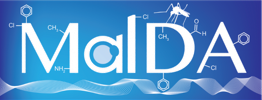Trisubstituted Pyrimidines as Efficacious and Fast-Acting Antimalarials.
Journal:
Journal of medicinal chemistry, Volume: 59, Issue: 13Abstract:
In this paper we describe the optimization of a phenotypic hit against Plasmodium falciparum, based on a trisubstituted pyrimidine scaffold. This led to compounds with good pharmacokinetics and oral activity in a P. berghei mouse model of malaria. The most promising compound (13) showed a reduction in parasitemia of 96% when dosed at 30 mg/kg orally once a day for 4 days in the P. berghei mouse model of malaria. It also demonstrated a rapid rate of clearance of the erythrocytic stage of P. falciparum in the SCID mouse model with an ED90 of 11.7 mg/kg when dosed orally. Unfortunately, the compound is a potent inhibitor of cytochrome P450 enzymes, probably due to a 4-pyridyl substituent. Nevertheless, this is a lead molecule with a potentially useful antimalarial profile, which could either be further optimized or be used for target hunting.
